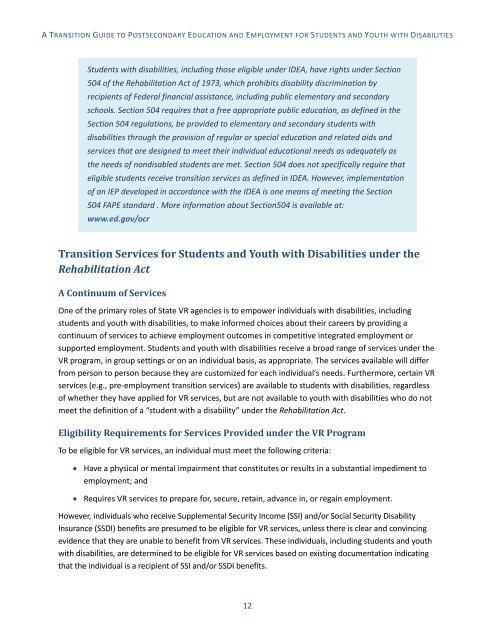TRANSITION GUIDE
2j9tM4H
2j9tM4H
You also want an ePaper? Increase the reach of your titles
YUMPU automatically turns print PDFs into web optimized ePapers that Google loves.
A <strong>TRANSITION</strong> <strong>GUIDE</strong> TO POSTSECONDARY EDUCATION AND EMPLOYMENT FOR STUDENTS AND YOUTH WITH DISABILITIES<br />
Students with disabilities, including those eligible under IDEA, have rights under Section<br />
504 of the Rehabilitation Act of 1973, which prohibits disability discrimination by<br />
recipients of Federal financial assistance, including public elementary and secondary<br />
schools. Section 504 requires that a free appropriate public education, as defined in the<br />
Section 504 regulations, be provided to elementary and secondary students with<br />
disabilities through the provision of regular or special education and related aids and<br />
services that are designed to meet their individual educational needs as adequately as<br />
the needs of nondisabled students are met. Section 504 does not specifically require that<br />
eligible students receive transition services as defined in IDEA. However, implementation<br />
of an IEP developed in accordance with the IDEA is one means of meeting the Section<br />
504 FAPE standard . More information about Section504 is available at:<br />
www.ed.gov/ocr<br />
Transition Services for Students and Youth with Disabilities under the<br />
Rehabilitation Act<br />
A Continuum of Services<br />
One of the primary roles of State VR agencies is to empower individuals with disabilities, including<br />
students and youth with disabilities, to make informed choices about their careers by providing a<br />
continuum of services to achieve employment outcomes in competitive integrated employment or<br />
supported employment. Students and youth with disabilities receive a broad range of services under the<br />
VR program, in group settings or on an individual basis, as appropriate. The services available will differ<br />
from person to person because they are customized for each individual’s needs. Furthermore, certain VR<br />
services (e.g., pre-employment transition services) are available to students with disabilities, regardless<br />
of whether they have applied for VR services, but are not available to youth with disabilities who do not<br />
meet the definition of a “student with a disability” under the Rehabilitation Act.<br />
Eligibility Requirements for Services Provided under the VR Program<br />
To be eligible for VR services, an individual must meet the following criteria:<br />
• Have a physical or mental impairment that constitutes or results in a substantial impediment to<br />
employment; and<br />
• Requires VR services to prepare for, secure, retain, advance in, or regain employment.<br />
However, individuals who receive Supplemental Security Income (SSI) and/or Social Security Disability<br />
Insurance (SSDI) benefits are presumed to be eligible for VR services, unless there is clear and convincing<br />
evidence that they are unable to benefit from VR services. These individuals, including students and youth<br />
with disabilities, are determined to be eligible for VR services based on existing documentation indicating<br />
that the individual is a recipient of SSI and/or SSDI benefits.<br />
12


